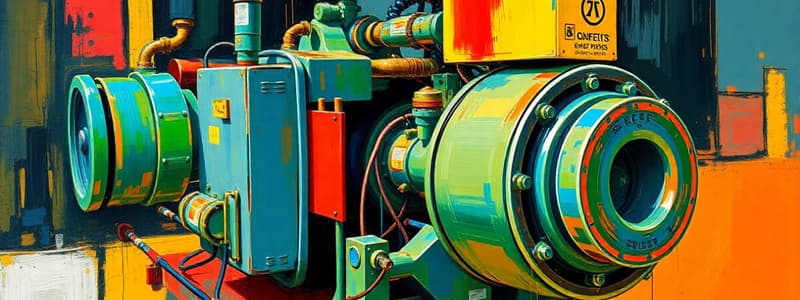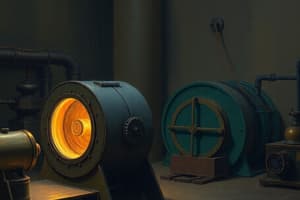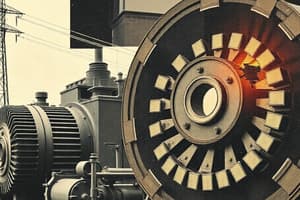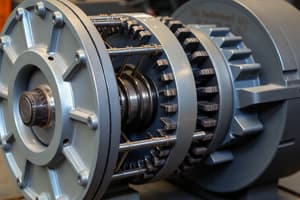Podcast
Questions and Answers
What is the purpose of the commutator in a DC generator?
What is the purpose of the commutator in a DC generator?
How many complete cycles of rotation are represented in the sine curve of a DC generator?
How many complete cycles of rotation are represented in the sine curve of a DC generator?
What happens during the process called commutation in a DC generator?
What happens during the process called commutation in a DC generator?
What variation is observed in the voltage developed across the brushes of a DC generator?
What variation is observed in the voltage developed across the brushes of a DC generator?
Signup and view all the answers
What is the main difference in construction between a DC generator and an AC generator?
What is the main difference in construction between a DC generator and an AC generator?
Signup and view all the answers
What are the two primary functions of a starter generator?
What are the two primary functions of a starter generator?
Signup and view all the answers
What is a key benefit of using starter generators in small turbine engines?
What is a key benefit of using starter generators in small turbine engines?
Signup and view all the answers
In starter mode, how do current flows operate within a starter generator?
In starter mode, how do current flows operate within a starter generator?
Signup and view all the answers
Which winding produces the field that induces voltage into the armature during generator mode?
Which winding produces the field that induces voltage into the armature during generator mode?
Signup and view all the answers
What component is NOT typically associated with starter generators?
What component is NOT typically associated with starter generators?
Signup and view all the answers
What element of DC generators can be affected by the design of the components?
What element of DC generators can be affected by the design of the components?
Signup and view all the answers
Which characteristic is NOT a function of DC motors?
Which characteristic is NOT a function of DC motors?
Signup and view all the answers
Which type of winding is primarily used in starter generators for starting only?
Which type of winding is primarily used in starter generators for starting only?
Signup and view all the answers
What is the effect of reducing current to the armature of a DC motor?
What is the effect of reducing current to the armature of a DC motor?
Signup and view all the answers
What is a key advantage of a compound motor?
What is a key advantage of a compound motor?
Signup and view all the answers
How does a cumulative compound motor behave under load?
How does a cumulative compound motor behave under load?
Signup and view all the answers
What characterizes a differential compound motor?
What characterizes a differential compound motor?
Signup and view all the answers
What determines the speed control in compound motors?
What determines the speed control in compound motors?
Signup and view all the answers
What is the role of the shunt field in a compound motor?
What is the role of the shunt field in a compound motor?
Signup and view all the answers
When is a differential compound motor typically used?
When is a differential compound motor typically used?
Signup and view all the answers
What configuration does a long shunt compound motor implement?
What configuration does a long shunt compound motor implement?
Signup and view all the answers
What is the primary function of compensating windings in a generator?
What is the primary function of compensating windings in a generator?
Signup and view all the answers
How do interpoles function in a generator?
How do interpoles function in a generator?
Signup and view all the answers
What is the effect of armature current on the generator's main magnetic field?
What is the effect of armature current on the generator's main magnetic field?
Signup and view all the answers
What is the relationship between increased load on a generator and motor reaction force?
What is the relationship between increased load on a generator and motor reaction force?
Signup and view all the answers
What must happen to the brushes in a generator once they have been accurately set?
What must happen to the brushes in a generator once they have been accurately set?
Signup and view all the answers
What type of connection do compensating windings have with the armature?
What type of connection do compensating windings have with the armature?
Signup and view all the answers
What happens to the neutral plane when compensating windings are utilized?
What happens to the neutral plane when compensating windings are utilized?
Signup and view all the answers
What is the purpose of creating a magnetic field with interpoles?
What is the purpose of creating a magnetic field with interpoles?
Signup and view all the answers
What happens when two parallel conductors carry current in the same direction?
What happens when two parallel conductors carry current in the same direction?
Signup and view all the answers
Which condition is NOT necessary for electromagnetic induction to occur?
Which condition is NOT necessary for electromagnetic induction to occur?
Signup and view all the answers
What is the role of the conductor in producing voltage through magnetism and motion?
What is the role of the conductor in producing voltage through magnetism and motion?
Signup and view all the answers
What is the effect of increasing the current flow in a DC motor's conductors?
What is the effect of increasing the current flow in a DC motor's conductors?
Signup and view all the answers
In the Left Hand Rule for Generators, what does the thumb represent?
In the Left Hand Rule for Generators, what does the thumb represent?
Signup and view all the answers
What effect does relative motion between a magnetic field and a conductor have?
What effect does relative motion between a magnetic field and a conductor have?
Signup and view all the answers
Where is maximum torque produced in a DC motor?
Where is maximum torque produced in a DC motor?
Signup and view all the answers
What role does the commutator play in a DC motor?
What role does the commutator play in a DC motor?
Signup and view all the answers
When two parallel conductors carry currents in opposite directions, what occurs?
When two parallel conductors carry currents in opposite directions, what occurs?
Signup and view all the answers
What happens to the counter emf if the armature's speed increases?
What happens to the counter emf if the armature's speed increases?
Signup and view all the answers
What is induced in a conductor when it moves through a magnetic field?
What is induced in a conductor when it moves through a magnetic field?
Signup and view all the answers
Which of the following statements about the conditions for producing voltage by magnetism and motion is true?
Which of the following statements about the conditions for producing voltage by magnetism and motion is true?
Signup and view all the answers
In which position do conductors produce no torque?
In which position do conductors produce no torque?
Signup and view all the answers
What is torque defined as in the context of a DC motor?
What is torque defined as in the context of a DC motor?
Signup and view all the answers
Which of the following statements about the direction of force in a DC motor is correct?
Which of the following statements about the direction of force in a DC motor is correct?
Signup and view all the answers
What mainly influences the strength of the counter emf in a DC motor?
What mainly influences the strength of the counter emf in a DC motor?
Signup and view all the answers
Study Notes
Module 3: Electrical Fundamentals - Topic 3.12: DC Motor/Generator Theory
- This topic covers DC motor and generator theory, components, and operation.
- Students should be able to describe basic motor and generator theory, identify DC generator components and their purpose, describe DC generator operation and factors affecting output and current flow, describe DC motor operation and factors affecting output power, torque, and speed, describe the operation and features of DC motor types (series wound, shunt wound, compound), and describe the construction and operation of starter generators.
- The left-hand rule is a simple rule for remembering the direction of a magnetic field around a conductor.
- The magnetic field around a current-carrying conductor is perpendicular to the conductor.
- Two parallel conductors with current flowing in the same direction have their magnetic lines of force combining, increasing the strength of the field around the conductors.
- Two parallel conductors with current flowing in opposite directions have their magnetic lines of force opposing, deforming the field around each conductor and causing repulsion.
- Electromagnetic induction is the production of an emf in a conductor by a changing magnetic field or by movement of the conductor through a magnetic field.
- When a conductor is placed in a magnetic field and either the field changes or the conductor moves through the field, an emf is induced.
- Three conditions must exist for an emf to be produced by magnetism: there must be a conductor in which voltage is produced, a magnetic field in the vicinity of the conductor, and relative motion between the field and conductor.
- A changing magnetic field or the movement of a conductor through a magnetic field induces an emf in a conductor.
- The voltage produced by magnetism and movement depends on three conditions: the conductor, the magnetic field, and relative motion between the field and conductor.
- A conductor moving through a magnetic field results in electrons being propelled, creating an electromotive force (emf) or voltage.
- The left-hand rule for generators can be used to determine direction of electron current flow for any conductor in a magnetic field.
- In a basic alternating-current generator, conductors cutting lines of force produce induced emf. The value of induced voltage varies at different points of rotation and shows a sine wave pattern.
- DC generators induce AC in the output windings, which is then rectified mechanically using a commutator and brushes to produce a DC output.
- A simple loop generator uses a 2-segment metal ring (commutator) to replace slip rings of an AC generator. This is the main difference in their construction.
- A commutator mechanically reverses armature loop connections to external circuit at the same instant that the polarity of voltage in armature loop reverses. This action is called commutation.
- The voltage across brushes in a DC generator fluctuates twice during each revolution between maximum and zero values – this variation is called ripple.
- DC generator construction involves a field frame or yoke, armature, commutators, and brushes.
- The field frame or yoke completes the magnetic circuit between poles and provides mechanical support.
- Small field generators are typically made of one piece of iron; larger generators use two parts bolted together.
- Field coil, and pole shoes are used to produce magnetizing force.
- Laminations are commonly used to reduce eddy currents in generators.
- Additional coils in an armature increase output voltage but reduce ripple.
- Adding more poles to the armature provides a stronger magnetic field and increases output voltage.
- Most modern generators use electromagnetic poles constructed from coils of insulated copper wire wound on soft iron cores.
- Varying input voltage modifies field strength, controlling generator output voltage.
- Brushes ride on the commutator surface, acting as electrical contacts between armature coils and the external circuit. They are typically high-grade carbon, sometimes with molybdenum for lubrication, and free to slide in their holders to account for wear.
- The commutator consists of wedge-shaped segments of hard drawn copper, insulated from each other by mica, and held in place by steel V-rings.
- Commutation is the successful reversal of current in an armature coil while under short circuit of a brush, and the mechanical conversion from AC to DC at the brushes of a DC machine.
- A commutator quickly reverses armature current to ensure constant current flow from the generator to the circuit.
- Current in coils should reverse linearly with time, with good commutation requiring proper coil positioning; brush assemblies are adjusted to ensure correct positioning.
- Commutation for 2 coils occurs simultaneously to briefly short-circuit the coils by brushes, producing no voltage and no sparking.
- The armature is mounted on a shaft, rotating via bearings in generator end frames, consisting of armature coils, a commutator, and other associated parts.
- The winding type is typically 2-layers, with the number of coils matching the armature slots and coil span set equal to 180 electrical degrees.
- Magnetic fields produced by armature current have a distorting effect on the main field, called armature reaction, requiring a shift in the neutral plane to prevent arcing between brushes and the commutator.
- Compensating windings, in series with the armature, can be used to mitigate armature reaction, ensuring a stationary neutral plane.
- Interpoles are small auxiliary poles placed between the main poles to cancel the shift in neutral plane caused by armature reaction, thus preserving a stable commutation.
- Current in the motor creates a magnetic force that opposes armature rotation, called motor reaction.
- Increasing current increases motor reaction, demanding higher driving force from the prime mover.
- Losses in DC generators include copper losses in windings, eddy current losses in the core, and hysteresis losses (magnetic friction).
- Copper losses are heat losses occurring during current flow through the armature windings, proportional to the square of the current and conductor resistance.
- Eddy current losses are heat losses due to induced currents (eddy currents) in the armature core material when it rotates within a magnetic field.
- Armature losses are minimized by using laminated cores, with laminations insulated from each other.
- Hysteresis losses result from changes in magnetization direction and are mostly reduced with silicon steel laminations through an annealing process.
- DC generator output voltage is affected by the number of conductor loops in series, armature speed, and magnetic field strength.
- Field excitation—applying a DC voltage to field windings—sets up a steady magnetic field, crucial for generator output.
- Separately excited generators utilize an independent power source for field excitation.
- The current for self-excited generators comes from the output of the generator itself, utilizing residual magnetism.
- DC motors, similar but not identical to DC generators, require control of input current rather than output voltage.
- Various types of DC motors (series, shunt, compound, and separately excited) differ in the connection of their field circuits.
- Series motors produce high starting torque due to the series connection of field windings with armature. However, speed varies significantly with load.
- Shunt motors have more consistent speed across varying loads, and use field windings parallel to the armature.
- Compound motors, combining series and shunt characteristics, offer good starting torque and relatively consistent speed but require more complex designs.
- Separately excited motors provide precise speed control by varying field current to manage output.
- Method of reversing motor direction involves reversing either armature or field current flow, usually achieved by employing a double pole, double throw switch.
- Armature reaction causes the neutral plane to shift in DC motors.
- Compensating windings, and interpoles are used to reduce the effects of armature reaction on the commutations.
- A starter generator combines a motor and a generator in a single unit, used where high torque is needed but consistent speed is not as crucial.
- The various design specifications for DC generators and motors depend on specific uses.
Studying That Suits You
Use AI to generate personalized quizzes and flashcards to suit your learning preferences.
Related Documents
Description
Test your knowledge on the workings of DC generators and starter generators. This quiz covers important concepts such as commutation, voltage variations, and construction differences. Ideal for students of electrical engineering or those interested in generator technologies.




